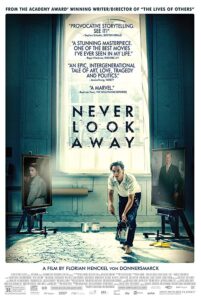How does a man survive not one, but two state-sanctioned hells in his lifetime?
German artist Gerhard Richter could tell you, if he wanted to – and maybe he did: in two respected works, Jurgen Schreiber biography “Ein Mahler aus Deutschland,” from 2005, and now, Florian Henckel-von Donnersmarck’s Oscar-nominated film “Never Look Away,” Richter’s traumatic life is exposed in haunting detail.


Regarded as Germany’s most important contemporary visual artist, Gerhardt Richter initially welcomed the attention from both the biographer and the filmmaker – only to distance himself from their finished works, according to a fascinating article by Dana Goodyear in a recent issue of The New Yorker.

Henckel-von Donnersmark spent three years on his screenplay for “Never Look Away,” mixing horrendous facts from Mr. Schreiber’s book with his own recollections of meeting and interviewing Richter.
It was important to the filmmaker to get it right this time. In 2007, at the age of 33, his first movie, “The Lives of Others,” won an Oscar for Best Foreign Language Film. A political thriller about Stasi, East-Germany’s infamous secret police agency, “The Lives of Others” is considered the most successful German-language film in history. It was made for $2 million, took in $77 million, and was greeted with world-wide accolades.
The young director’s career was set to soar, but Hollywood money and Hollywood stars beckoned him into making “The Tourist”(2010), a pointless $100 million tourist-caper (Venice!) starring the biggest names of its day, Angelina Jolie and Johnny Depp.

With “Never Look Away,” Henckel-von Donnersmark is back on safe ground. He knows his subject, his knows the eras his protagonist traverses. He has a story to tell, and in order to tell it without constraints, the movie is Gerhard Richter’s only according to a few important facts:
Yes, the hero is a German artist (played by Tom Schilling) who achieves fame and riches after suffering severe trauma before, during, and after the Second World War. Yes, he’s still the child who loses classmates during the fire bombing of Dresden, the two uncles who are killed on the Eastern Front, the beloved aunt who is euthanized, the father who hangs himself, the mother, who – no, mercifully, we are spared her rape by the Russians.

We do watch him marry into a Nazi family and we discover that his father-in-law (Sebastian Koch) is directly responsible for the young aunt’s murder.
The hero has a different name, however. Here he is Kurt Barnert, a child prodigy at the start (1937) of the film. He is taken by his teenage Aunt Elisabeth (Saskia Rosendahl) to an exhibit of “degenerate art” in Dresden. Kandinsky and Mondrian are shown under headings of “The Principle of Insanity” and “How Sick Minds See Nature.” While a docent hectors his audience about correct and incorrect art, Elisabeth bends down to her nephew and whispers, “But I like it. Everything that’s true is beautiful. Nie Weg sehen. Never look away.”
It will take a while for Kurt to understand what Elisabeth means. He does remembers not to look away, but he doesn’t always understand what it is he sees.
After the war, stuck in a Germany occupied by the Soviet Union, he attends art school. “New” art is still bad, he’s told. Picasso is held up as a warning – “he started out well but slipped into decadence.” The individual must still serve a collective. The fatherland and Hitler in one era, Comrades and Stalin in the next one. In both Nazi-Germany and DDR, Kurt has to deny his individualism.
He manages for a while. With Panglossian verve, he paints colorful murals teeming with DDR heroes, cheerful farmers and laborers. Kurt is a favored student, he is happily married, the future looks bright.

And yet… not knowing his father-in-law’s grotesque past, he senses something is wrong in the house he and his wife, a fellow art student (Paula Beer), must share with her parents. Before the Berlin Wall is built, the young couple escapes to the West and ends up in Dusseldorf, where Kurt attends an art school that is equally frustrating to the one he just left. In the West, he has the freedom to ask “Who am I?” – and he is stumped.
How Kurt finds himself and his artistic vision is Henckel-von Donnersmark’s interpretation of Gerhard Richter’s salvation through “the healing power of art.” The most dramatic scenes in “Never Look Away” may never have happened in real life, but they seemed entirely plausible. Truth is blended with imagination, seamlessly.
Without Caleb Deschanel’s breathtaking photography, many of the devastating scenes in the film would have been unbearable to watch. “Never Look Away” has earned the world-renowned American cinematographer his sixth Oscar nomination.
The cast is flawless. Of special note: Oliver Masucci in the small, unforgettable part of
Kurt’s art professor in Dusseldorf.
“Never Look Away” is three hours and eight minutes long. In German, with subtitles.
